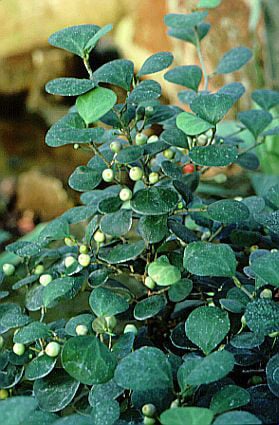Ficus deltoidea
mistletoe fig
An evergreen shrub to 5m or more, with broadly obovate, glossy rich green leaves to 8cm, ochre or rusty-brown beneath. Young plants have narrowly lance-shaped leaves; fruits small, dull orange or red

Size
Ultimate height
4–8 metresTime to ultimate height
10–20 yearsUltimate spread
1.5–2.5 metresGrowing conditions
Moisture
Moist but well–drainedpH
Acid, Alkaline, NeutralColour & scent
| Stem | Flower | Foliage | Fruit | |
| Spring | Green | Green | ||
|---|---|---|---|---|
| Summer | Green | Red Orange | ||
| Autumn | Green | Orange | ||
| Winter | Green |
Position
- Full sun
Aspect
South–facing or East–facing
Exposure
Sheltered Hardiness
H1BBotanical details
- Family
- Moraceae
- Native to GB / Ireland
- No
- Foliage
- Evergreen
- Habit
- Bushy
- Potentially harmful
- Skin allergen. Wear gloves and other protective equipment when handling
- Genus
Ficus can be evergreen or deciduous trees, shrubs or climbers, with often leathery, simple, entire or lobed leaves and tiny flowers borne within a hollow receptacle which enlarges to form the fruit
- Name status
Correct
- Plant range
- S E Asia
How to grow
Cultivation
Grow outdoors in humus-rich moist but well-drained soil in full sun or partial shade with protection from wind in a frost-free area. Grow under glass in peat-free, loam-based compost in full or filtered light
Propagation
Propagate by seed, leaf-bud or semi-hardwood cuttings
Suggested planting locations and garden types
- Patio and container plants
- Low Maintenance
Pruning
Pests
May be susceptible to glasshouse red spider mite, thrips, mealybugs and scale insects under glass
Diseases
May be susceptible to honey fungus
Get involved
The Royal Horticultural Society is the UK’s leading gardening charity. We aim to enrich everyone’s life through plants, and make the UK a greener and more beautiful place.